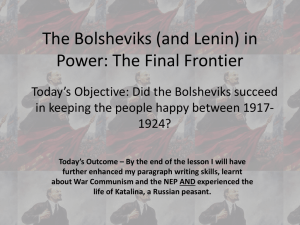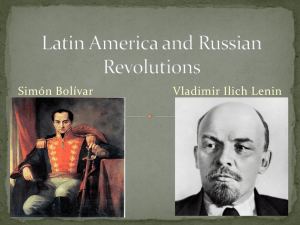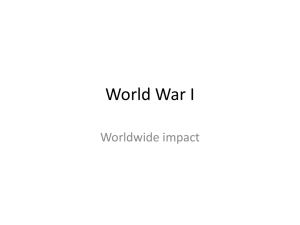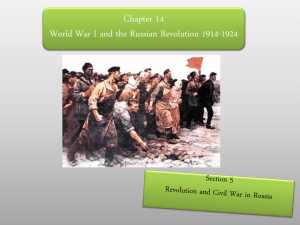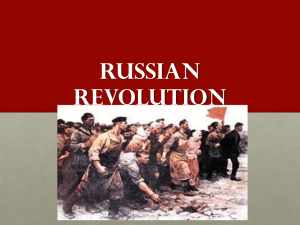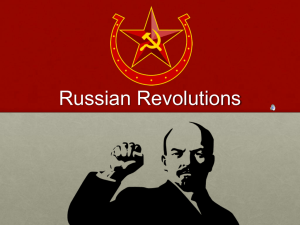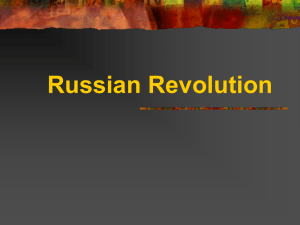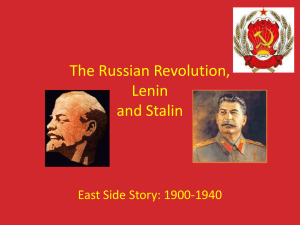Lenin2-1917-1924
advertisement
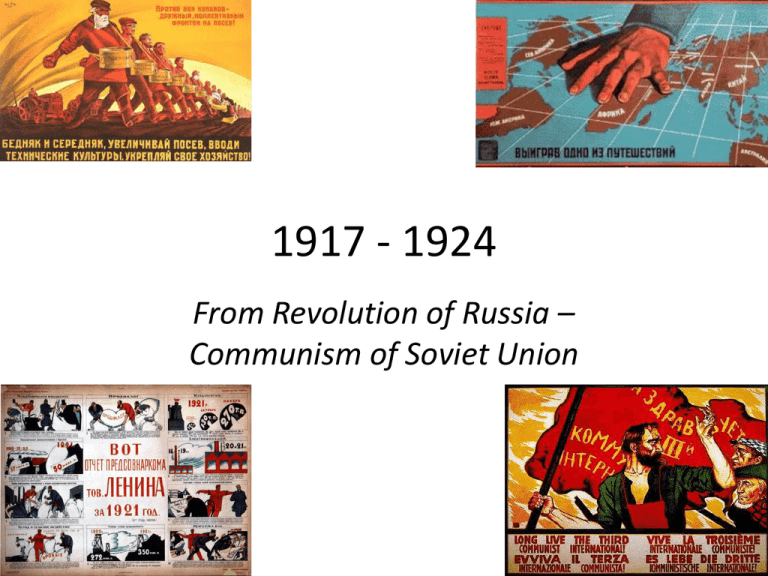
1917 - 1924 From Revolution of Russia – Communism of Soviet Union The All-Russian Congress 1917 • The Bolsheviks remained a significant minority within the broad group of Communists & Social Revolutionaries. The AllRussian Congress of Soviets (June 1917) showed the following breakdown: (C) W. McSweeney 2011 2 August-November 1917: Total Revolution Failing Provisional Government: Bolsheviks Seize Power: Due to deeply-unpopular shortages, combined with the continuing sacrifices, at home and at the war front, The Provisional Govt. began to lose its grip on control of the newly-democratic, yet highlyunstable Russia. • *October 25th – Bolsheviks seized principal buildings of Petrograd. • Lvov appoints Kerensky in August. • Lenin installed as Chairman of the new Bolshevik Russian Government. • Kerensky formed a unpopular coalition government of Liberals & Moderate Socialists. • Seized the Winter Palace – HQ of Kerensky’s Provisional Government. • Lenin & Bolsheviks still only controlled area around Petrograd. *November 7th on Gregorian Calendar (C) W. McSweeney 2011 3 Lenin’s Russia Over the next 6 years, Russia would be transformed through a series of strategies & events: 1. Consolidating Bolshevik supremacy in Russia 2. Lenin & the Treaty of Brest – Litovsk 3. The Russian Civil War 1918 – 1921 4. Lenin’s War Communism 5. The Kronstadt Rebellion 6. The Comintern 7. The New Economic Policy (C) W. McSweeney 2011 4 The First Days of Leninism • Lenin believed that Western Europe would soon be swept by International Communism. In fact, this was a goal of the Bolsheviks.* (Comintern) • Therefore, he concluded that Peace was the priority cause – “Peace, Land, Bread” • In order to achieve peace, Lenin had to withdraw all Russian forces from World War I. He personally ‘drove through’ the harsh terms of the Treaty of Brest-Litovsk. • Bolsheviks were still a minority within the larger family of Communists & Social Revolutionaries. (C) W. McSweeney 2011 5 Treaty of Brest-Litovsk (March 1918) • Trotsky (negotiating for Russia) initially walked out on excessive German demands – “No Peace, No War” • Russia ceded Poland & her Baltic lands to Germany & AustriaHungary. • Russia also recognised the independence of the Ukraine & Finland. • Trotsky resented these severe losses, but in Lenin’s mind, it mattered little and he insisted on Russia’s acceptance. Russia lost: 30% of agricultural land 30% of population 50% of industry (C) W. McSweeney 2011 6 Consolidating Bolshevik Control 1918 – 1920 Consolidating Economic Control • Once in power, Lenin & the Bolsheviks began seizing businesses, banks & property. • They nationalised all these private entreprises & assets. • • Church property & nobles’ land was seized. All private property was abolished. Consolidating Political Power Elections, scheduled by the Provisional Govt. were allowed to go ahead. However, the Bolsheviks only gained 175 seats out of 700. Lenin closed the democratic Assembly after one day in January 1918. • The new Bolshevik secret police – ‘Cheka’ arrested & executed all those who protested or criticised Lenin and/or Bolsheviks – who now called themselves ‘Communists’ • After a failed assassination attempt on Lenin, Bolshevik forces launched a ‘Red Terror’ campaign in late 1918, rooting out all resistance to Bolshevik control. • Women got the vote. Land was given to the peasants. ‘Dictatorship of the Proletariat’? (C) W. McSweeney 2011 7 Russian Civil War 1918 - 1920 Reds v. Whites The Reds were the Bolsheviks (Communists) and believed in revolution through armed insurrection coupled with political organisation. Their single-handed closing down of all democratic assemblies & crushing of opposition through the ‘Red Terror’, while introducing Nationalisation, served to provoke a massive backlash from other groups in opposition to them. The Whites were mainly the Mensheviks who believed in slow, gradual & peaceful transformation of society. They opposed bitterly the methods and single-handed rule of the Reds and were joined by Tsarists & Social Revolutionaries in a bid to oust the new Bolshevik (Communist) Government. They would receive outside aid (money & armies) from the USA, France, Britain & Japan.* ‘Whites’ associated with being anti-Russian – foreign aid & intervention (C) W. McSweeney 2011 8 Russian Civil War 1918 - 1920 Lenin’s ‘War Communism’ • • Lenin introduced ‘War Communism’ during the Civil War struggle. Bolsheviks effectively controlled only Petrograd & Moscow at beginning of Civil War. This involved seizing food for factory workers to feed factory workers in Petrograd & Moscow. The Red Guards were central to this State requisition (‘requisition squads’ Whites’ Confusion • Efforts by the Whites were confused due to their different backgrounds and aims: Tsarists – Return to Tsar Rule? Cadets – Return to Liberal Democracy? Social Revolutionaries/ Mensheviks – Pure Socialism? & system of forced quotas.) • By 1920, the skill of Leon Trotsky had transformed the Red Guards into the Red Army, which was highly-motivated, unified & well-fed. The Civil War was effectively won. (C) W. McSweeney 2011 9 Red Guards seized food from agricultural peasants, but in 1920 a famine occurred after they refused to grow food. ‘War Communism’ & Civil War Kronstadt Rebellion (March 3, 1921) Roots of Kronstadt Rebellion • The harshness of the Bolsheviks towards the peasants especially during the Civil War, left many people wondering just what kind of ‘social justice’ they had supported in revolution. Also, the Bolsheviks were the smallest group of reformers at the All-Russian Congress of 1917. Legitimacy? • The effects of ‘War Communism’ on the peasants especially aroused anger in otherwise supportive groups, such as the Russian sailors. • The closing of the new democratic Assembly in January 1918 aroused deep anger & suspicion amongst many peasants, soldiers & sailors. • While most peasants, soldiers & sailors supported vast reforms of the old Tsar system, they were afraid of replacing ‘one tyrant with another’. The Petropavlovsk The famed rebellion of the battleship ‘Potemkin’ during the 1905 Revolution was an uncomfortable comparison for the Bolsheviks while they attempted to suppress the Kronstadt Rebellion, led by Stephan Petrichenko http://www-personal.umich.edu/~mhuey/TOC/KRN.frame.html (C) W. McSweeney 2011 10 Kronstadt Naval Base (C) W. McSweeney 2011 St Petersburg/Petrograd/Leningrad 11 Kronstadt Rebellion "I am simultaneously giving orders to prepare for the suppression of the rebellion and the subjugation of the sailors by armed force. All responsibility for the harm that may be suffered by the peaceful population will rest entirely on the heads of the White Guard mutineers. This warning is final.“ - L.Trotsky, L.Kamenev, Ultimatum to Kronstadt. "We have one answer to all that: All power to the Soviets! Take your hands off them - the hands that are red with the blood of the martyrs of freedom who fought the White Guards, the landowners and the bourgeoisie!“ • Note the reference by Trotsky & Kamenev to the “..White Guard mutineers.” • Note also the response by the Kronstadt rebels – “All Power to the Soviets”…. “Take your hands off them” – “the hands that are red with the blood of …martyrs…who fought the White Guards, the landowners and the bourgeoisie” • Both sides accused the other of being enemies of the people and of the broad revolution in 1917. • Kronstadt Naval base had a long and chequered reputation of being ‘independent’ & revolutionary. The famous 1905 incident of the Potemkin was probably the most memorable incident of anti-Tsar revolt during that period, later to be immortalised in the film ‘The Potemkin’ (1925). • During the 1917 Revolution, naval ships had participated in crushing General Kornilov’s failed retrograde attack on Petrograd. - Kronstadt Izvestiya, No.6. (C) W. McSweeney 2011 12 Kronstadt Rebellion – True Communism or Counter-Revolution? • Demands of Kronstadt Sailors – A Broader Consensus On February 27, 1921, the Petrograd Strike Committee had issued the following demands to Lenin’s Bolshevik Government: “The whole policy of the government must undergo a thorough change, and first and foremost the workers and peasants must have their freedom. They do not want to follow Bolshevist leaders; they want to decide their own lot for themselves. You must therefore put forward the following demands urgently and in an organized way: • Kronstadt Naval base was only the most prominent centre of antiBolshevism during the early years of the new Russia. • The Petrograd Soviet had issued a damning indictment (only 5 days • before the Kronstadt Rebellion) of Lenin’s ‘War Communism’ but more importantly, had openly criticised • Lenin for the abolition of democratic rights & institutions. • • “The release of all socialist and non-party workers who have been arrested.” “The abolition of the state of siege.” “Freedom of speech, the press, and meeting for all working classes.” “Free voting in new elections for the factory committees, trade unions and Soviets.” (C) W. McSweeney 2011 13 Kronstadt Postscript • Lenin & the Bolsheviks eventually crushed the mutiny in Kronstadt on the night of March 16th, 1921. Conspirators, sailors & fishermen were executed for their part in the mutiny. • This represented the last significant effort to oust Bolshevism or alter its excessively dictatorial position and ideology. • Showed the deep division & contrast between the popular uprising of the February Revolution of 1917, the more limited revolution of October 1917 & ultimately the narrow, despotic rule of Bolshevism during the Russian Civil War & Kronstadt Mutiny. • The policies of ‘War Communism’, the closing of the National Assembly in January 1918 and suppression of democratic rights by the ‘Cheka’ had all contributed to the mutiny in Kronstadt. (C) W. McSweeney 2011 14 Communist International – The ‘Comintern’ The Third International, 1919 – 1943: "by all available means, including armed force, for the overthrow of the international bourgeoisie and for the creation of an international Soviet republic as a transition stage to the complete abolition of the State.“ Zinoviev – Chairman of ‘Comintern’ 1919 -1928 Aim: To spread Communism to other nations, particularly focusing on western capitalist countries. The Comintern assisted and eventually, over a number of years, began to control the activities of foreign Communist parties. (C) W. McSweeney 2011 15 Lenin’s New Economic Policy 1921 (C) W. McSweeney 2011 16 War Communism N.E.P. “The collapse of the productive forces surpassed anything of the kind that history had ever seen. The country, and the government with it, were at the very edge of the abyss.” - Leon Trotsky “I ask you, comrades, to be clear that the New Economic Policy is only a temporary deviation, a tactical retreat.” - Zinoviev The harsh realities of War Communism, coupled with the real demands of the peasants as portrayed by the Kronstadt Rebellion, made it clear to Lenin that War Communism was neither economically effective nor popular with the peasants. In response to this, Lenin sought to rescue both the economic well-being of the country and restore confidence in the Bolshevik Party by introducing a ‘New Economic Policy’. It had elements of quasi-capitalism, allowing for small businesses to open and allowing peasants to sell their surplus grain for profit. (C) W. McSweeney 2011 17 New Economic Policy Rationale: Ostensibly, Lenin wanted to revive the economic well-being of Russia. In reality, Lenin was aware of the failure of ‘War Communism’ and wanted to appeal to the peasants for continued support. He also wanted to ‘defuse’ any lingering discontent after the death of 1,000 Russian sailors and the repression by the State in Kronstadt. New Economic Policy: 1. Tax on peasants’ harvests. (lower than the terms of War Communism) 2. Peasants allowed to sell excess produce for profit. 4. Foreign trade & investment was encouraged in the hope that it would revive the faltering Russian economy 5. Bonuses were introduced in the workplace (incentives) 6. A state bank was established & Lenin directed the formation of a state economic planning commission – ‘Gosplan’ – to help direct future funding & development of the Russian economy. 3. Although state control remained on all large-scale businesses and banking, small businesses were allowed to open. (C) W. McSweeney 2011 18 New Economic Policy (C) W. McSweeney 2011 19 Results: By 1924, 40% of Russian domestic trade was sourced in private businesses. The economy flourished with industrial and agricultural output reaching pre-war levels (see graph). Consequences: 1. The end of restrictions on private small businesses was a blow to die-hard Communists, yet it reflected the pragmatism of Lenin who realised Russia could not instantaneously move to ‘pure Communism’. The Communist die-hards saw it as a betrayal and Lenin faced severe criticism from some quarters. 2. This pragmatism however, stabilised Russia sufficiently in an economic sense to allow Lenin to pursue the total transformation (politically) of Russia into the USSR. 3. The first attempt at State Planning was introduced under the ‘Gosplan’ & although it was not in anyway truly Communist (foreign trade, small private businesses) it did allow Russia to begin catching up on Western countries’ prosperity levels. (C) W. McSweeney 2011 20 ‘Constructivism’ – A Communist Art Form (C) W. McSweeney 2011 21 Union of Soviet Socialist Republics (USSR) - 1922 Treaty of Creation of the USSR (1922) The following countries/republics were unified under the title USSR from 1922 onwards: • Russian, Ukrainian, Byelorussian & Transcaucasian Soviet Republics were all amalgamated into the USSR in 1922. • More states would be subsumed into the USSR at later dates. • The Constitution of the USSR codified & made legal the union of soviet socialist republics in 1924. (C) W. McSweeney 2011 22 Centralised, Dictatorial Bolshevism of the USSR – “Dictatorship of the Proletariat?” • By 1921, it became clear that Lenin’s ideal was one of a centralised, authoritarian Bolshevik government ruling over the entire Russian territories. • In 1922, Russia became the USSR (Union of Soviet Socialist Republics), but in reality Russia – at the centre of the Soviet Union, became the effective principal state of leadership and authority. • ‘What is To Be Done?’ - Lenin, 1902. In this essay on the future of revolutionary planning, Lenin does betray his desire to rule Russia in an authoritarian way. By the time of Lenin’s death in 1924, the USSR had been safely founded with the amalgamation of neighbouring territories into a larger, unified, politically-centralised economic power (C) W. McSweeney 2011 23 Soviet Union in 1924 • After Lenin died in 1924, a ‘power vacuum’ opened up over the leadership of the Bolshevik Party & the USSR. • This ‘power vacuum’ would define the course of Soviet History for the next thirty to forty years. The contenders for Lenin’s position were mainly two men: Ideological Battle of Leadership in USSR Leon Trotsky - a devout believer in ‘International Socialism’ & head of the Red Army v. Joseph Stalin – quiet and introverted, General Secretary of the Communist Party, he began to favour what he would eventually call ‘Socialism in One Country’ (C) W. McSweeney 2011 24 Leadership Power Struggle Begins in USSR http://www.marxists.org/archive/lenin/quotes.htm - Lenin’s quotes on Socialism, Communism, the Proletariat & Revolution (C) W. McSweeney 2011 25 (C) W. McSweeney 2011 26

